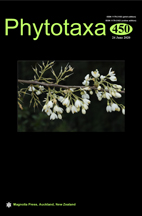Abstract
Aeschynanthus monetaria, a beautiful epiphytic species of Gesneriaceae, was rediscovered in monsoon rain forest along the Yarlung Zangbo River in Motuo County, Southeast Tibet (Xizang), China. Its description is amended and completed with both fresh and dried specimens in this discovery. To better facilitate its identification, the color images in the field and line illustrations based on our specimens are given. A taxonomic note concerning its lectotype and the ending of specific epithet is discussed.

